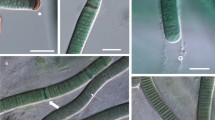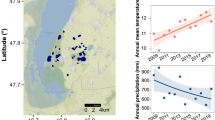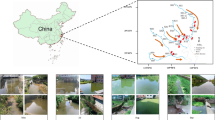Abstract
Cyanobacteria are major components of Antarctic Dry Valley ecosystems. Their occurrence in lakes and ponds is well documented, however, less is known about their distribution in edaphic environments. There has been considerable debate about the contribution of aquatic organic matter derived largely from cyanobacteria to terrestrial ecosystems. In this study, automated rRNA intergenic spacer analysis (ARISA) and 16S rRNA gene clone libraries were used to investigate cyanobacterial diversity in a range of soil environments within the Miers and Beacon Valleys. These data were used to elucidate the input of aquatic cyanobacteria to soil communities. Thirty-eight samples were collected from a variety of soil environments including dry and moist soils, hypoliths and lake and hydroterrestrial microbial mats. The results from the ARISA and 16S rRNA clone library analysis demonstrated that diverse cyanobacterial communities exist within the mineral soils of the Miers Valley. The soil samples from Beacon Valley were depauparate in cyanobacterial signals. Within Miers Valley, significant portions (29%–58%) of ARISA fragment lengths found in aquatic cyanobacterial mats were also present in soil and hypolith samples, indicating that lacustrine and hydroterrestrial cyanobacteria play a significant role in structuring soil communities. The influence of abiotic variables on the community structure of soil samples was assessed using BEST analysis. The results of BEST analysis of samples from within Miers Valley showed that total percentage of carbon content was the most important variable in explaining differences in cyanobacterial community structure. The BEST analyses indicated that four elements contributed significantly to species compositional differences between valleys. We suggest that the complete absence of lakes or ponds from Beacon Valley is a contributing factor to the low cyanobacterial component of these soils.
Similar content being viewed by others
Log in or create a free account to read this content
Gain free access to this article, as well as selected content from this journal and more on nature.com
or
Accession codes
References
Adams BJ, Bardgett RD, Ayres E, Wall DH, Aislabie J, Bamforth S et al. (2006). Diversity and distribution of Victoria Land biota. Soil Biol Biochem 38: 3003–3018.
Aislabie JM, Chhour K, Saul DJ, Miyauchi S, Ayton J, Paetzold RF et al. (2006). Dominant bacteria in soils of marble point and Wright Valley, Victoria Land, Antarctica. Soil Biol Biochem 38: 3041–3056.
Avery SA, Howlett NG, Radice S . (1996). Copper toxicity towards Saccharomyces cerevisiae: dependence on plasma membrane fatty acid composition. Appl Environ Microbiol 62: 3960–3966.
Baker AN . (1967). Algae from lake Miers, a solar heated Antarctica lake. NZ J Bot 5: 453–468.
Barrett JE, Virginia RA, Hopkins DW, Aislabie J, Bargagli R, Bockheim JG et al. (2006a). Terrestrial ecosystem processes of Victoria Land, Antarctica. Soil Biol Biochem 38: 3019–3034.
Barrett JE, Virginia RA, Wall DH, Cary SC, Adams BJ, Hacker AL et al. (2006b). Co-variation in soil biodiversity and biogeochemistry in northern and southern Victoria Land, Antarctica. Antarct Sci 18: 535–548.
Bartsevich VV, Pakrasi HB . (1996). Manganese transport in the cyanobacterium Synechocystis sp. PCC 6803. J Biol Chem 271: 26057–26061.
Broady PA . (1996). Diversity, distribution and dispersal of Antarctic terrestrial algae. Biodivers Conserv 5: 1307–1335.
Broady PA . (2005). The distribution of terrestrial and hydro-terrestrial algal associations at three contrasting locations in southern Victoria Land, Antarctica. Arch Hydrobiol Suppl Algol Stud 118: 95–112.
Brown MV, Schwalbach MS, Hewson I, Fuhrman JA . (2005). Coupling 16S-ITS rDNA clone libraries and automated ribosomal intergenic spacer analysis to show marine microbial diversity: development and application to a time series. Environ Microbiol 7: 1466–1479.
Burkins MB, Virginia RA, Wall DH . (2001). Organic carbon cycling in Taylor Valley, Antarctica: quantifying soil reservoirs and soil respiration. Glob Chang Biol 7: 113–125.
Cavacini P . (2001). Soil algae from northern Victoria Land (Antarctica). Polar Biosci 14: 45–60.
Cavet JS, Borrelly GPM, Robinson NJ . (2003). Zn, Cu and Co in cyanobacteria: selective control of metal availability. FEMS Microbiol Rev 27: 165–181.
Chisholm SW, Falkowski PG, Cullen JJ . (2001). Discrediting ocean fertilization. Science 294: 309–310.
Clarke KR . (1993). Non-parametric multivariate analysis of changes in community structure. Aust J Ecol 18: 117–143.
Clarke KR, Gorley RN . (2006). PRIMER v6: User Manual. Plymouth Marine Laboratory: Plymouth, UK.
Cockell CS, Stokes MD . (2004). Widespread colonization by polar hypoliths. Nature 431: 414.
Cowan DA, Ah Tow L . (2004). Endangered antarctic environments. Annu Rev Microbiol 58: 649–690.
Cowan DA, Russell NJ, Mamais A, Sheppard DM . (2002). Antarctic Dry Valley mineral soils contain unexpectedly high levels of microbial biomass. Extremophiles 6: 431–436.
Coyne KJ, Hutchins DA, Hare CE, Cary SC . (2001). Assessing temporal and spatial variability in Pfiesteria piscicida distributions using molecular probing techniques. Aquat Microb Ecol 24: 275–285.
de los Ríos A, Ascaso C, Wierzchos J, Fernández-Valiente E, Quesada A . (2004). Microstructural characterization of cyanobacterial mats from the McMurdo Ice Shelf, Antarctica. Appl Environ Microbiol 70: 569–580.
Doran PT, McKay CP, Clow G, Dana G, Fountain A, Nylen T et al. (2002). Valley floor climate observations from the McMurdo Dry Valleys, Antarctica 1986–2000. J Geophys Res 21: 4772.
Fisher MM, Triplett EW . (1999). Automated approach for ribosomal intergenic spacer analysis of microbial diversity and its application to freshwater bacterial communities. Appl Environ Microbiol 65: 4630–4636.
Foley KK, Lyons WB, Barrett JE, Virginia RA . (2007). Pedagenic carbonate distribution with glacial till in Taylor Valley, Southern Victoria Land, Antarctica. In: Alonso-Zarza AM, Tanner LH (eds). Paleoenvironmental Record and Applications of Calcretes and Palustrine Carbonates. GSA Special Papers. Geological Society of America: Boulder, CO. pp 89–104.
Gugger M, Lyra C, Henriksen P, Coute A, Humbert JF, Sivonen K . (2002). Phylogenetic comparison of the cyanobacterial genera Anabaena and Aphanizomenon. Int J Syst Evol Microbiol 52: 1867–1880.
Hewson I, Steele JA, Capone DG, Fuhrman JA . (2006). Remarkable heterogeneity in meso- and bathypelagic bacterioplankton assemblage composition. Limnol Oceanogr 51: 1274–1283.
Horowitz NH, Cameron RE, Hubbard JS. . (1972). Microbiology of the dry valleys of Antarctica. Science 176: 242–245.
Jungblut A, Hawes I, Mountfort D, Hitzfeld B, Dietrich DR, Burns BP et al. (2005). Diversity within cyanobacterial mat communities in variable salinity meltwater ponds of McMurdo Ice Shelf, Antarctica. Environ Microbiol 7: 519–529.
Kennedy AD . (1993). Water as a limiting factor in the Antarctic terrestrial environment: a biogeographical synthesis. Arct Alp Res 25: 308–315.
Kotchoni SO, Gachomo EW, Betiku EB, Shonukan OO . (2003). A home made kit for plasmid DNA mini-preparation. Afr J Biotechnol 4: 86–87.
Lane DJ, Pace B, Olsen GJ, Stahl DA, Sogin ML, Pace NR . (1985). Rapid determination of 16S ribosomal RNA sequences for phylogenetic analyses. Proc Natl Acad Sci USA 82: 6955–6959.
Moorhead DL, Barrett JE, Virginia RA, Wall DH, Porazinska D . (2003). Organic matter and soil biota of upland wetlands in Taylor Valley, Antarctica. Polar Biol 26: 567–576.
Muyzer G, de Waal EC, Uitterlinden AG . (1993). Profiling of complex microbial populations by denaturing gradient gel electrophoresis analysis of polymerase chain reaction-amplified genes coding for 16S rRNA. Appl Environ Microbiol 59: 695–700.
Nagpal ML, Fox KF, Fox A . (1998). Utility of 16S–23S rRNA spacer region methodology: how similar are interspace regions within a genome and between strains for closely related organisms? J Microbiol Methods 33: 211–219.
Newton RJ, Kent AD, Triplett EW, McMahon KD . (2006). Microbial community dynamics in a humic lake: differential persistence of common freshwater phylotypes. Environ Microbiol 8: 956–970.
Nkem JN, Wall DH, Virginia RA, Broos EJ, Barrett JE, Porazinska DL et al. (2005). Wind dispersal of soil invertebrates in the McMurdo Dry Valleys, Antarctica. Polar Biol 29: 346–352.
Novis PM, Smissen RD . (2006). Two genetic and ecological groups of Nostoc commune in Victoria Land, Antarctica, revealed by AFLP analysis. Antarct Sci 18: 573–581.
Parker BC, Simmons GM, Wharton RA, Seaburg KG, Love FG . (1982). Removal of organic and inorganic matter from Antarctic lakes by aerial escape of blue-green algal mats. J Phycol 18: 72–78.
Ranjard L, Poly F, Lata JC, Mougel C, Thioulouse J, Nazaret S . (2001). Characterization of bacterial and fungal soil communities by automated ribosomal intergenic spacer analysis fingerprints: biological and methodological variability. Appl Environ Microbiol 67: 4479–4487.
Schloss PD, Hay AG, Wilson DB, Walker LP . (2003). Tracking temporal changes of bacterial community fingerprints during the initial stages of composting. FEMS Microbiol Ecol 46: 1–9.
Smith JJ, Ah Tow L, Stafford W, Cary SC, Cowan DA . (2006). Bacterial diversity in three different Antarctic cold desert mineral soils. Microb Ecol 51: 413–421.
Suroszl W, Palinska KA . (2004). Effects of Heavy-metal stress on cyanobacterium Anabaena flos-aqua. Arch Environ Contam Toxicol 48: 40–48.
Taton A, Grubisic S, Balthasart P, Hodgson DA, Laybourn-Parry J, Wilmotte A . (2006a). Biogeographical distribution and ecological ranges of benthic cyanobacteria in East Antarctic lakes. FEMS Microbiol Ecol 57: 272–289.
Taton A, Grubisic S, Brambilla E, De Wit R, Wilmotte A . (2003). Cyanobacterial diversity in natural and artificial microbial mats of Lake Fryxell (McMurdo Dry Valleys, Antarctica): a morphological and molecular approach. Appl Environ Microbiol 69: 5157–5169.
Taton A, Grubisic S, Ertz D, Hodgson DA, Piccardi R, Biondi N et al. (2006b). Polyphasic study of Antarctica cyanobacterial strains. J Phycol 42: 1257–1270.
Thomas DN . (2005). Photosynthetic microbes in freezing deserts. Trends Microbiol 13: 87–88.
Ugolini FC, Bockheim JG, Anderson DM . (1973). Soil development and patterned ground evolution in Beacon Valley, Antarctica. In: North American Contribution, Permafrost, Second International Conference, 13–28 July, 1973. Yakutsk, USSR, National Academy of Sciences: Washington, DC. pp 246–254.
Vincent WF . (1988). Microbial Ecosystems in Antarctica. University Press: Cambridge, UK.
Vincent WF, Downes MT, Castenholz RW, Howard-Williams C . (1993). Community structure and pigment organisation of cyanobacteria-dominated microbial mats in Antarctica. Eur J Phycol 28: 213–221.
von Wintzingerode FV, Goebel UB, Stackebrandt E . (1997). Determinations of microbial diversity in environmental samples: pitfalls of PCR-based rRNA analysis. FEMS Microbiol Rev 21: 213–229.
Voytek MA, Priscu JC, Ward B . (1999). The distribution and relative abundance of ammonia-oxidizing bacteria in lakes of the McMurdo Dry Valley, Antarctica. Hydrobiologia 401: 113–130.
Whitton BA, Potts M . (2000). The Ecology of Cyanobacteria, Their Diversity in Time and Space, 1st edn. Kluwer Academic Publishers: Dordrecht, The Netherlands.
Zar JH . (1974). Biostatistical Analysis. Prentice-Hall Inc: Englewood Cliffs, NJ, USA.
Acknowledgements
We acknowledge Antarctica New Zealand for logistic support to SCC and DAC. The research was also partially supported through a grant from the National Science Foundation (OPP-0229836 and EPSCoR-0447610) to SCC. We especially thank Steve Cameron and Anjana Rajendram (Waikato University) for assistance with soil chemistry analysis. We are indebted to Lisa Robson (Waikato University) and Stephanie Burton (University of Cape Town) for field assistance. SAW thanks the New Zealand Foundation for Research, Science and Technology for post-doctoral fellowship funding (CAWX0501). Dean Olsen (Cawthron Institute) is gratefully acknowledged for assistance with statistical analysis.
Author information
Authors and Affiliations
Corresponding author
Rights and permissions
About this article
Cite this article
Wood, S., Rueckert, A., Cowan, D. et al. Sources of edaphic cyanobacterial diversity in the Dry Valleys of Eastern Antarctica. ISME J 2, 308–320 (2008). https://doi.org/10.1038/ismej.2007.104
Received:
Revised:
Accepted:
Published:
Issue date:
DOI: https://doi.org/10.1038/ismej.2007.104
Keywords
This article is cited by
-
Seasonal Variation of Hypolithic Microbiomes in the Gobi Desert
Microbial Ecology (2023)
-
Bringing Antarctica to the lab: a polar desert environmental chamber to study the response of Antarctic microbial communities to climate change
Polar Biology (2023)
-
Towards an Environmental Classification of Lentic Aquatic Ecosystems in the McMurdo Dry Valleys, Antarctica
Environmental Management (2021)
-
Biotic interactions are an unexpected yet critical control on the complexity of an abiotically driven polar ecosystem
Communications Biology (2019)
-
Diversity of key genes for carbon and nitrogen fixation in soils from the Sør Rondane Mountains, East Antarctica
Polar Biology (2018)



